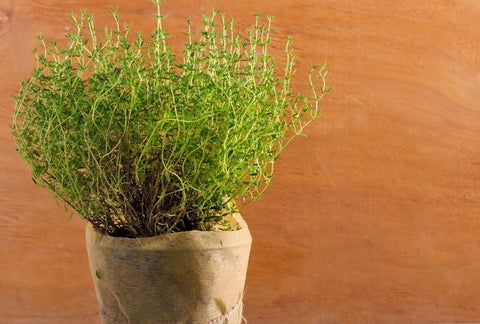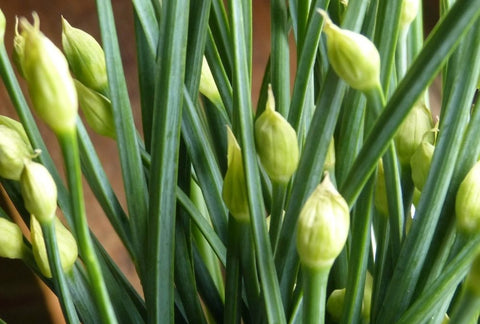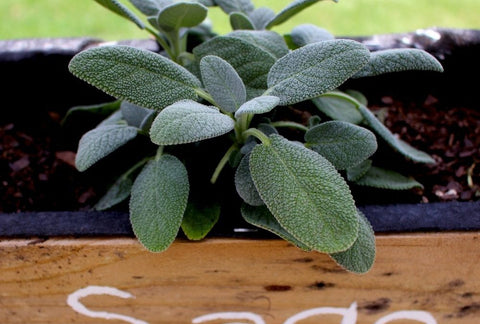Thyme's name was derived from the Greek word thumus, or courage, because in Medieval times knights wore sprigs of thyme on their armor as a sign of bravery. In this blog, we’ll cover everything you need to know to successfully grow thyme indoors - from basic facts, supplies, setup, and steps to grow, and how to care for and harvest it.
| Plant type | Perennial |
| Family | Lamiaceae |
| Binomial name | Thymus vulgaris |

Timing
Thyme sprouts in 2-3 weeks. It can be harvested from month 3 onwards.

Part sun
Thyme plants need an equivalent of 5+ hours of direct sun (DLI of 15+ mol/m²/day).

Care
Growing thyme indoors is very beginner-friendly. You’ll sprout, thin, prune, and harvest.
Table of Contents
Ways to Grow Thyme | Care and Maintenance | Timeline & Steps | Cultivars/Varieties
Ways to Grow Thyme Plant Indoors
Growing Thyme Indoors Using Soil vs Hydroponics vs Microgreens
Growing Thyme Indoors Using Soil
Growing thyme indoors is relatively easy, but take note that they don’t do well in moist soil conditions. The roots are not accustomed to being too wet and will rot in boggy conditions. On the other hand, if the soil dries out completely, the roots will die back and the plant won’t recover. This can catch you off guard because the plant’s not very expressive (its leaves don’t wilt) so it will look fine right up until it dies.
Growing Thyme Indoors Using Hydroponics
Unlike other herbs, thyme does not grow well in hydroponic systems such as the aerogarden. This is due to it preferring drier conditions.
Equipment Needed for Growing Thyme Indoors Using Soil
We prefer using a Ceramic Self Watering Planter filled with a free-draining potting mix that self-regulates to keep the soil on the drier side, but with a little consistent moisture (and means no watering guesswork for you). Careful of wick-based self-watering planters with Thyme - as they tend to be too wet.
To set one up:
- Fill up the planter with dry soil from the bag, gently tamping down the top.
- Dump the soil into a large mixing bowl and add water until the soil is moist, but not sopping wet (about ½ Cup).
- Mix in 1 tablespoon of the Balanced Blend Plant Food.
If you are using a regular pot instead, it should be a little bit bigger (at least 6" / 1 quart) and will need drainage holes to prevent it from being overwatered. Let the top of the soil dry out between watering.
Growing Thyme Indoors as Microgreens
Thyme, just like other herbs, can definitely be grown as microgreens. In addition to the much shorter time to harvest (in days, not months), they are also best used as garnishes and to add flavor to savory dishes, soups, and pasta. Click here to learn more about the different types of microgreens (herbs being one of them), or grab a copy of our eBook to learn more about all the different ways you can grow thyme (and more!) at home.
Care and Maintenance of Thyme Indoors
Lighting for Growing Thyme Indoors
Like all edible plants, Thyme plants need lots of light to grow and develop good flavor. Sunlight is excellent for plant growth (and free!) and you might be lucky enough to have a spot that’s got the 5+ hours of direct sun they need. Even with a bright window, it’s unlikely that you’ll have enough natural light in the winter so we recommend a grow light for anyone who wants a constant supply of flavorful produce.
For an introduction to grow lights, head over to our post on grow lights for indoor gardeners. We’ve also got a buying guide for screw-in types.

How bright should your grow light be?
Thyme plants need the equivalent of 5+ hours of direct sunlight (DLI of 15+ mol/m²/day) to grow their best. In order to provide an equivalent amount with a grow light, it needs to be pretty bright! The 24W Sansi bulb should be placed 6 inches away from the top of the plant. This will give your PPFD (the standard measure of brightness) of 500 μmol/m²/s. Learn more about optimal grow light setup for your indoor garden here.
How many hours per day do your Thyme plants need under a grow light?
Thyme plants are what’s known as “day-neutral” so can grow under a range of daylight lengths. In order for them to get enough light, we recommend setting up a timer to leave it on for 10+ hours per day.
Right Temperature for Your Thyme Plant Indoors
Thyme Plants Grow Faster in Warmer Temps
Thyme plants are called “warm-weather crops” and will speed up their metabolism when temperatures are warmer. On the other hand, if things get too hot they’ll wilt and become prone to disease. Ideal temperatures are around 70°F but anything between 65 and 85°F grows well.
Water and Humidity
Herbs such as thyme thrive on an adequate amount of moisture but can suffer if they’re waterlogged, so make sure to water them just enough, especially if you’re using soil. To avoid your thyme being waterlogged, make sure to use a pot with drainage, or just use self-watering pots, as mentioned above.
Nutrients and Fertilizers for Your Thyme Plant Indoors
Thyme likes to start with nutrients that are equal parts nitrogen, phosphorus, and potassium (with NPK numbers like 10-10-10). For this Balanced Blend, we recommend: Dr Earth All Purpose
Once they are growing, it’s better to use plant food that is high in nitrogen (with NPK numbers like 10-5-5). For this Herb Blend, we recommend: Joyful Dirt All Purpose
Moving Your Thyme Plant Outdoors
As we talked about above, thyme mostly thrives in warm temperatures due to them being warm-weather crops, so we suggest moving them outdoors only when the temperature is warm enough. To learn more about how to grow your thyme outdoors, check this out.
Timeline and Steps on How to Grow Thyme Indoors
Best Setup for Your Thyme Plant Indoors
Below is the best setup (and a very easy one!) for growing your thyme plants indoors. You’ll need:
Thyme Planter:
Ceramic Self Watering Planter or pot that is at least 6" / 1 quart.
Soil:
Free-Draining Mix
Plant Food:
At the start: Balanced Blend. This should be equal parts nitrogen, phosphorus, and potassium (with NPK numbers like 10-10-10).
Ongoing: Herb Blend. This should be high in nitrogen (with NPK numbers like 10-5-5).
Grow Light:
A strong grow light that can give the equivalent of 5+ hours of direct sun (DLI of 15+ mol/m²/day).
Starting Your Thyme: Seed vs Cutting vs Nursery Plant
New Thyme plants can be started from seed, propagated from an established plant, or purchased live at many garden centers. When growing thyme indoors, we prefer to sprout from seed or propagate from a stem cutting, as it results in plants that are adapted to your growing conditions and limit the chances that you accidentally bring home pests.
How to Plant Thyme Seeds

Thyme grows quickly from seed. Plant 1 site in a 6" / 1-quart container. In larger containers, space sites 4" apart. For each site, press 4 seeds into the surface. Keep the soil warm (60-70°F, ideally 65°F). Sprouts typically appear in 21 days but can be as quick as 14 days or as long as 28 days depending on your conditions. Don't cover the seeds as light helps them sprout. To speed things up, you can soak them in water for 12-24 hours before planting.
Propagating Thyme: How to Clone from a Stem Cutting

If you’ve already got a Thyme plant you love (or a friend does!) you can easily “clone” it with just sharp scissors and a clean glass of water. First, cut a couple of 6” shoots of new growth (avoid anything woody). Next, remove the lower leaves, so the bottom half is just stem.
Place in a glass of 3” of water, making sure the cut leaf spots are underwater. Place the glass on a bright windowsill and change the water every few days. In a couple of weeks, roots should emerge and you can transplant them into your container. While using additional rooting hormones won't hurt, it’s not necessary with Thyme plants.
- Cut 6” section of new growth
- Remove leaves halfway and place them in the water on a sunny windowsill
- Wait 42 days for a few ½ inch roots to form and carefully transplant into its final container
How to Transplant Thyme

Live starter plants give you a big jump start on your first harvest. When you’re in a garden center - pick the bushiest plant available (tall and lanky ones will be weak growers) and give it a good inspection for pests. Leaves should be dark green without holes, spots, or curled edges. A best practice is to actually “quarantine” your plant for about a week after bringing it home to make sure it's free and clear of ride-on pests.
Ensuring it’s pest and disease-free it’s time to transplant your seedling into its final home.
- Remove some soil from its final planter - leaving enough space for the bottom of the seedling to be just higher than the soil surface.
- Hold on to the base of the stem with one hand, and turn the pot over while gently pulling the seedling. Giving the pot a few squeezes can help dislodge it.
- Place in its final container and fill around it with soil so that it’s tight, but not compacted.
Week 2-3: Check for Sprouts
You could see seedlings in as little as 14 days (though 21 days is more typical). If it’s been 28 days and you still don’t have any sprouts, it’s likely that your setup is too cold.
Week 5: Thin Your Seedlings

Thin your planter to only have 1 seedling per site - leaving the largest plant. If you are using the recommended planter (at least 6" / 1 quart) this will mean you’ve got 1 plant after thinning. By getting rid of the smaller seedlings, you’re allowing the biggest and strongest one to flourish by reducing its competition for water, food, and space.
If your seedlings are under 1 inch, stretching out, or folding over, it’s likely that they don't have quite enough light.
Month 2: How to Prune Thyme Plants

Once your Thyme plant has 3 sets of mature leaves you’re ready for your prune. Cut off the top set of mature leaves, leaving the bottom two (it’s best to cut right above the pair of leaves you’re keeping on the plant). Once these branches grow out (and each has a few sets of their own leaves) you can cut the tip - just as you did with the main stem. At this point your plant will be fairly well-shaped, so hone your inner Bonsai master and use your thinning and heading cuts to harvest and shape your herbs as you go.
Month 3+: How to Harvest Thyme
For peak flavor, harvest right before flowers start to open by cutting the plant ~1.5" from the ground.
How to Use Your Freshly-Harvested Thyme in Cooking
Thyme is a versatile herb with an earthy and slightly minty flavor. It can be used in many ways:
- Garnish for soups, pasta, sandwiches, and pizza.
- Mixed in savory dishes for an added distinct taste.
- Made into teas and cocktails.
- Check out some more of our favorite thyme recipes here.
How to Preserve Herbs such as Thyme
There are several ways to preserve or keep your herbs fresh, and here are just some of the easiest and the ones we recommend the most:
- Lazy person technique: Keep the fresh herbs in their original packaging and simply store them in the fridge.
- Storing the herbs in a glass of water inside the fridge: Cut the end of the stem, fill a glass jar or cup with water, and place your herb inside, like a vase or bouquet of herbs!
- Keep in a glass of water under natural lighting.
- Wrap loosely in a damp paper towel.
- Freeze them: You can freeze fresh herbs such as thyme to use at a later time. All you need are some ice cube trays and a freezer, and you’re all set.
Learn more about how to preserve and keep your herbs and thyme fresh here.
Year 10+: End of Life
Thyme, as a perennial plant, can live for a very long time if the conditions are right.
If you’d like to learn about the dozens of other herbs, fruits, and vegetables that you can grow indoors, then grab a copy of our free eBook below.
How to Grow Thyme Indoors: Best Thyme Varieties to Grow Inside
So what really is the answer to the question “how to grow thyme indoors?” First, you need to consider which of its varieties you can grow indoors. Dozens of varieties are available for thyme, but I have listed the most common upright and creeping thymes that are best for growing indoors.
| Variety | Common/French | Lemon | Wooly | Caraway |
| Type | Upright | Upright | Creeping | Creeping |
| Why We Like Them | It plays well with all its Mediterranean pals, including rosemary, oregano, marjoram, and sage. It's also taken by mouth for bronchitis, whooping cough, sore throat, etc. | It may be added to poultry, seafood, vegetable, marinades, stews, soups, sauces, and stuffing while fresh sprigs of this herb make a lovely garnish. | It is used as a flavoring in food. The leaves, and especially the essential oil contained in them, are strongly antiseptic, deodorant, and disinfectant. | It contains essential oil, has antiseptic, deodorant, and disinfectant use as well. It also has uses in perfumery, as a mouthwash, and as traditional medicine. |
| Purchase Link | Urban Leaf | Seedman | Amazon | Mountain Valley Growers |
We hope that this blog has given you everything you need to know about growing thyme indoors. In case you have any questions, just leave a comment below.









There are no comments for this article. Be the first one to leave a message!